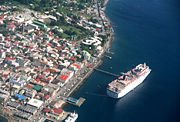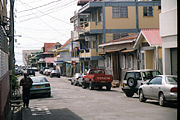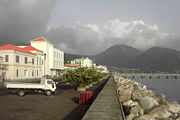Roseau
| Roseau | |
 |
|
| Nickname(s): Town | |
|
|
|
| Country | Dominica |
|---|---|
| Parish | Saint George |
| Government | |
| - Type | Local Government-Roseau City Council est 1890s |
| - His Worship Mayor | Cecil Joseph |
| - MP - Roseau Central | Hon. Norris Prevost |
| Population (2001) | |
| - Total | 14,847 |
Roseau (Kwéyòl: Wozeau) is the capital and largest city of Dominica. Its population is 14,847 (2001 census),[1] It is a small and compact urban settlement, located within the Saint George parish and surrounded by the Caribbean Sea, the Roseau River and Morne Bruce. Built on the site of the ancient Kalinago Indian village of Sairi, it is the oldest and most important urban settlement on the island.
It is located on the west (leeward) coast of Dominica, and is a combination of modern and colonial (French Style) architecture.
Some exports include bananas, bay oil, vegetables, grapefruit, oranges and cocoa, servises.
It is the see of the Roman Catholic Diocese of Roseau.
Contents |
Overview
The central district of Roseau is tightly packed with small and large houses and even larger modern concrete structures. There is little green or open space situated within the city, and this is even more so today, as many of the courtyards which was once commonplace within the city are giving way to office space. The district is, however, framed in every direction by natural elements. The sea and the river provide water element while the Botanical Gardens and the Government House gardens frame the city with green space. Both these elements are rare in the Caribbean. No other centre in the region has such extensive botanical gardens with such central location, and the Roseau River is amongst the largest rivers that flow through any Caribbean capital.
The urban structure of Central Roseau is based on an irregular grid system of miniature proportions, making it a highly illegible city. Even though the grid area is not very extensive, it is relatively easy for a visitor to get lost there. The grid area has some 80 blocks in the area of 30 hectares (74 acres). In comparison, the grid areas of Kingstown and Castries — capitals of Saint Vincent and Saint Lucia — have some 50 and 60 blocks in the areas of over 40 ha (99 acre). The average block size in Central Roseau is thus some ⅓ hectare (1 acre), i.e. about half of the figure of Central Kingstown.
History

The city of Roseau sits on an alluvial fan formed hundreds of years ago as the river after which it was named meandered across the area from what is now known as Newtown to its current location. Over the last two thousand years Amerindians migrating through the islands settled the area attracted by the nearby river. With the arrival of the Europeans on the island in the 16th and 17th centuries, a small settlement was established by the French who in their tradition of naming places after what they found there named the settlement with their name for the river reeds which grew along the river banks. A plan was created for the settlement which mirrored examples in France where streets extended from a central point at what is today the Old Market and extended out to the rest of the settlement.
Conflict raged between the French and the British over the area on several occasions. Finally the British gained a stronghold and by the late 18th and early 19th centuries set out plans for the city which included fortifications and government structures, the grid road street system and blocks and new urban areas to the north and south known today as Potter's Ville and Newtown. Goodwill was established in the 1950s and Bath Estate in the early 1980s. Since that several new semi-urban settlements — such as Stock Farm, Castle Comfort and Wall House — have been constructed around the existing ones. Some older settlements like Fond Cole and Canefield nowadays belong also to the semiu-rban area that lies around Roseau.
The French influence can still be seen today, however, in its architecture, and crooked streets which extend from the Old Market Plaza. Examples of the English influence is also evident in architecture and street names.[2]
Architecture
There are some fine examples of West Indian in Roseau. The ones that stand out the most is the French Colonial style and the vernacular form. Much of the French influence can be found along King George V Street. Around the city you will come across some good examples of the English influence in the form of large colonial town houses and colonial public/government buildings.
The churches in Roseau are fine examples of Europe in Dominica with a bit of creolisation. The Roman Catholic Cathedral stands prominent in Gothic Romanesque revival and the Anglican Church on Victoria Street in Georgian style. Amongst these buildings you will find much of the urban vernacular squeezed in between larger colonial and more modern buildings.
City life
Because of the suburban sprawl, few people live in Central Roseau, but more of them daily commute. Motorised vehicles pour into the central district thus introducing a mode of point-to-point interaction in an environment that was created for multiple use. As elders said, first there were no streets but just a space between the buildings. The streets of Roseau, and especially those of its central district, are not only ways to move from place to place but they are places themselves. They are used as gardens, playing fields and social meeting places.

The Botanical Gardens on the fringes of the central district are a relaxing place if compared to the busy downtown area. They are, however, mostly used by children. Several schools are situated in the vicinity of the gardens, and groups of school children in their blue or brown uniforms populate the gardens along with tourists. When there is a cricket match, however, people gather to the sides of the Cricket Ground to watch the game.
Sports and recreation
Within the city of Roseau, there are many opportunities for recreation. Many persons seek out the tranquility and cool of the Botanical Gardens as a getaway on Sunday afternoons and at lunch. As well, it is a popular venue for local cricket matches and sports training. Football is a popular sport; there are several pitches throughout the city area (at Newtown, Potters Ville, and Bath Estate), as well as in the sports stadium at Windsor Park.
Sporting facilities and infrastructure
There are dedicated sports facilities around the city. Private tennis courts are located on High Street; netball and basketball courts also abound in the city's major high schools. These are complemented by community facilities at Goodwill. A dedicated netball and basketball stadium is located at Stockfarm near the Dominica State College.
In 2007, Windsor Park, also home to the Dominica National Football Team, was completed with the generous donation of EC$33 million from the government of the People's Republic of China.
Elsewhere in the city it is not uncommon to find that a section of the street, sidewalk or even the beach has been adapted to makeshift games of cricket or football.
Popular sports include netball, basketball, rounders and (to a much lesser extent) tennis.
Accommodations and Infrastructure
There are no world famous hotel chains in the city. The most famous hotel is the Fort Young Hotel.[3] In addition there are several small family owned establishments within and on the outskirts of the city.
Dominica Broadcasting Corporation, the national radio station, and two other private radio stations is located in the capital.
Non Governmental Organizations
Roseau is home to service clubs including, Kiwanis, Rotary and Lions. There are other organisations such as the local humane society and conservation society.
The Dominica Association of Industry and Commerce, Waitukubuli Eccological Foundation, Dominica Tourism Association and others are based in the city.
The city is also home to several labour organisations including the Dominica Amalgamated Workers' Union, the Dominica Public Service Union, the Dominica Trade Union, the National Workers' Union and the Waterfront and Allied Workers' Union
Communication
As the most important town on the island and hub of all business activity, the city is a central point of the road networks on the island. It is an important link between northern, eastern, and southern bound traffic. As a result its streets are frequently clogged with busy workers, shoppers and schoolchildren. When there is a cruiseship in port, many are amazed at how the narrow streets of the town accommodate the needs of all these users.
The city is also served by a nearby small aircraft airport which provides direct link to the nearby islands as well as occasionally to the larger Melville hall airport to the north. the ferry terminal provides direct link to the neighbouring Guadeloupe to the north and Martinique and St. Lucia to the south.
There are no rail or subway systems.
Education
Roseau has been the historical centre of education on the island. There are six secondary schools located in the city as well as eight primary schools. A community college - The Dominica State College is also located in Roseau. A private medical school, All Saints School of Medicine, has recently moved into the city.
Embassies & Consulates
Several embassies are also located in the city. Among them include the Venezuelan Embassy and the Chinese Embassy with a couple of other consulates located around the city.
Scenery

Roseau's nearby scenery (mostly in its so-called valley) includes Boiling Lake, 6.5 miles (10.5 km) east, in the Morne Trois Pitons National Park, waterfalls, thermal springs, and scenic plateaus.
Morne Bruce provides panoramic views of most of downtown Roseau and northwards toward Woodbridge Bay deepwater port and Fond Cole. From Morne Bruce there are also views of the Botanic Garderns at its base as well as the Caribbean Sea which look quite spectacular on cruise ship days when several cruise liners are in port.
Notable people
- Dominica's most famous writer and novelist, Jean Rhys, was born in Roseau on August 24 1894
- NBA basketball player Garth Joseph was born in the town on August 8 1973.
- Dame Mary Eugenia Charles, former Prime Minister and first woman prime minister in the Caribbean. Was instrumental in the Development of the Organisation of Eastern Caribbean States and in the US invasion of Grenada in the 1980s.
- Gordon Henderson of the Cadence-Lypso Band Exile One.
- Tarina Simon, Digicel 2008 Rising Star
- Leandra Lander, 2007 holder of four Caribbean Pageant Titles.
Development
Roseau is carded to see a number of developments in the short to long term future which as described by government officials will transform the city into a premier city in the Caribbean. Some of these developments include:
1. Roseau Road Reinstatement Program - replacement and rehabilitation of many of the city's streets and sidewalks.
2. The construction of an additional bridge across the river from bathroad which will connect to a new street and further to Rose Street in Goodwill. As part of this project another road will be constructed along the river bank and the Windsor Park Stadium to connect with Valley Road alongside the new DGS project. Further road projects include a proposed new road along the back of the Botanical Gardens and the Public cemetery which will connect Elmshall Road to Bath Road.
3. Phases 3, 4, & 5 of the new state of the art Dominica Grammar School which will enhance universal secondary education on the island. Plans for the demolition of the historic old building is also planned.
4. Construction of a new building for the Goodwill Secondary School.
5. Rehabilitation and expansion of the Princess Margaret Hospital funded by the Chinese.
6. Botanical Gardens restoration and rehabilitation already under way.
7. Various SHAPE guided activities which has already seen the preservation of some of the city's magnificent historic and cultural buildings.
8. Possible replacement of the West Bridge with a two lane bridge.
9. Construction of a vendors' arcade at the ruins near the old market paza - a restoration project.
10. West Coast Road Project; proposed construction of another pridge over the river over the estuary to connect the Dame Eugenia Charles Boulevard to Goodwill Road.
11. Widening of the Elmshall Road to make it safer and more passable in the event of landslides. Work has already begun with the reclamation of the cliff side with material excavated from the Windsor Park Satdium Site and road work in the Roseau Valley.
12. Expansion of the riverside apartments to include two new structures similar to the exsiting ones north of this site.
13. River Defense Project; already underway in the vicinity of the riverside apartments in an area known as Underpower. The Minister of Public Works has indicated plans to restore the natural pool that once existed in the area.
See also
- Canefield Airport
- [1]
- [2]
- Roseau Photo Gallery
- Photo slideshow and travelogue from Roseau
References
- ↑ Commonwealth of Dominica, Population and Housing Census — 2001. Roseau, Dominica: Central Statistical Office, Ministry of Finance and Planning, Kennedy Avenue, 2001.
- ↑ Niko Lipsanen, Naturalistic and existential realms of place in Roseau, Dominica. University of Helsinki, Department of Geography 2001.
- ↑ Fort Young Hotel